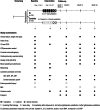Multicentre, randomized, double-blind, prospective study on the effects of ImmunoAdSorptiOn on cardiac function in patients with Dilated CardioMyopathy (IASO-DCM): Rationale and design
- PMID: 39359033
- PMCID: PMC11659496
- DOI: 10.1002/ejhf.3476
Multicentre, randomized, double-blind, prospective study on the effects of ImmunoAdSorptiOn on cardiac function in patients with Dilated CardioMyopathy (IASO-DCM): Rationale and design
Abstract
Aims: Pilot studies indicate that immunoadsorption with subsequent IgG substitution (IA/IgG) induces beneficial effects in patients with dilated cardiomyopathy (DCM) and heart failure. This placebo-controlled study investigates whether IA/IgG treatment enhances left ventricular (LV) systolic function as compared to a control group receiving pseudo-treatment.
Methods: This multicentre, randomized, double-blind, parallel-group trial aims to include 200 patients with heart failure due to DCM (LV ejection fraction [LVEF] <40%) on optimized guideline-directed heart failure medication. Participants are randomly assigned in a 1:1 ratio to IA/IgG using protein-A columns, or to pseudo-immunoadsorption followed by an intravenous infusion without IgG. Follow-up visits take place by telephone after 1 and 3 months and at the study centres after 6, 12 and 24 months. The primary efficacy endpoint is the change in LVEF from baseline to 6 months determined by contrast echocardiography, analysed at a core lab. In addition, LV end-diastolic and end-systolic volumes will be analysed as secondary endpoints over the entire study period to assess whether IA/IgG affects LV remodelling. As main secondary outcome, a composite of all-cause death, cardiac resuscitation, hospitalization for heart failure, and need for cardiac surgery to improve myocardial pump function will be evaluated after 24 months. In addition, exploratory outcomes as well as safety endpoints related to the treatment will be assessed throughout the whole study period.
Conclusion: IASO-DCM is a randomized study which will provide comprehensive insights into the effects of immunoadsorption with subsequent IgG substitution in patients with DCM.
Keywords: Dilated cardiomyopathy; Heart failure; IgG substitution; Immunoadsorption; Randomized controlled trial.
© 2024 The Author(s). European Journal of Heart Failure published by John Wiley & Sons Ltd on behalf of European Society of Cardiology.
Figures


References
-
- Caforio AL, Pankuweit S, Arbustini E, Basso C, Gimeno‐Blanes J, Felix SB, et al. Current state of knowledge on aetiology, diagnosis, management, and therapy of myocarditis: A position statement of the European Society of Cardiology Working Group on Myocardial and Pericardial Diseases. Eur Heart J 2013;34:2648a–2648d. 10.1093/eurheartj/eht210 - DOI - PubMed
Publication types
MeSH terms
Substances
Grants and funding
LinkOut - more resources
Full Text Sources
Research Materials
Miscellaneous

